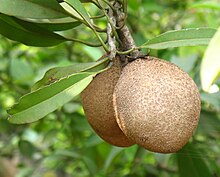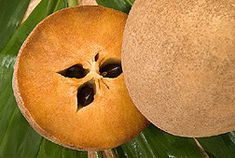
Back سبوتة مألوفة Arabic سبوته مالوفه ARZ Sabo BAN Tsiko BCL Саподила Bulgarian चीकू Bihari Sawu BJN Tubabusi BM সফেদা Bengali/Bangla Sapote Catalan
| Manilkara zapota | |
|---|---|

| |
| Scientific classification | |
| Kingdom: | Plantae |
| Clade: | Tracheophytes |
| Clade: | Angiosperms |
| Clade: | Eudicots |
| Clade: | Asterids |
| Order: | Ericales |
| Family: | Sapotaceae |
| Genus: | Manilkara |
| Species: | M. zapota
|
| Binomial name | |
| Manilkara zapota (L.) P.Royen
| |
| Synonyms | |
 Fruit, cross-section | |
| Nutritional value per 100 g (3.5 oz) | |
|---|---|
| Energy | 347 kJ (83 kcal) |
19.96 g | |
| Dietary fiber | 5.3 g |
1.1 g | |
0.44 g | |
| Vitamins | Quantity %DV† |
| Riboflavin (B2) | 2% 0.02 mg |
| Niacin (B3) | 1% 0.2 mg |
| Pantothenic acid (B5) | 5% 0.252 mg |
| Vitamin B6 | 2% 0.037 mg |
| Folate (B9) | 4% 14 μg |
| Vitamin C | 16% 14.7 mg |
| Minerals | Quantity %DV† |
| Calcium | 2% 21 mg |
| Iron | 4% 0.8 mg |
| Magnesium | 3% 12 mg |
| Phosphorus | 1% 12 mg |
| Potassium | 6% 193 mg |
| Sodium | 1% 12 mg |
| Zinc | 1% 0.1 mg |
| †Percentages estimated using US recommendations for adults,[2] except for potassium, which is estimated based on expert recommendation from the National Academies.[3] | |
Manilkara zapota, commonly known as sapodilla (Spanish: [ˌsapoˈðiʝa]),[4] sapote, chicozapote, chicoo, chicle, naseberry, nispero, or soapapple, among other names,[5][6]: 515 is an evergreen tree native to southern Mexico and Central America. An example natural occurrence is in coastal Yucatán, in the Petenes mangroves ecoregion, where it is a subdominant plant species.[7] It was introduced to the Philippines during Spanish colonization.[8] It is grown in large quantities in Mexico and in tropical Asia, including India, Pakistan, Thailand, Malaysia, Cambodia, Indonesia, Vietnam, Bangladesh, as well as in the Caribbean.
- ^ Martínez Salas, E.; Samain, M. & Oldfield, S. (2021). "Manilkara zapota". IUCN Red List of Threatened Species. 2021: e.T61964429A61964470. Retrieved 23 June 2022.
- ^ United States Food and Drug Administration (2024). "Daily Value on the Nutrition and Supplement Facts Labels". FDA. Archived from the original on 2024-03-27. Retrieved 2024-03-28.
- ^ National Academies of Sciences, Engineering, and Medicine; Health and Medicine Division; Food and Nutrition Board; Committee to Review the Dietary Reference Intakes for Sodium and Potassium (2019). Oria, Maria; Harrison, Meghan; Stallings, Virginia A. (eds.). Dietary Reference Intakes for Sodium and Potassium. The National Academies Collection: Reports funded by National Institutes of Health. Washington, DC: National Academies Press (US). ISBN 978-0-309-48834-1. PMID 30844154. Archived from the original on 2024-05-09. Retrieved 2024-06-21.
- ^ USDA, NRCS (n.d.). "Manilkara zapota". The PLANTS Database (plants.usda.gov). Greensboro, North Carolina: National Plant Data Team. Retrieved 23 June 2022.
- ^ "Manilkara zapota". Germplasm Resources Information Network. Agricultural Research Service, United States Department of Agriculture. Retrieved 23 June 2022.
- ^ Small, Ernest (2011). Top 100 Exotic Food Plants. Boca Raton, Louisiana, USA: CRC Press. p. 515–524. ISBN 9781439856888.
- ^ World Wildlife Fund. eds. Mark McGinley, C.Michael Hogan & C. Cleveland. 2010. Petenes mangroves. Encyclopedia of Earth. National Council for Science and the Environment. Washington DC Archived 2011-10-15 at the Wayback Machine
- ^ Fernandez, Doreen G. (1997). Fruits of the Philippines. Makati City, Luzon, Philippines: Bookmark Inc. p. 22. ISBN 9715692613.
© MMXXIII Rich X Search. We shall prevail. All rights reserved. Rich X Search
